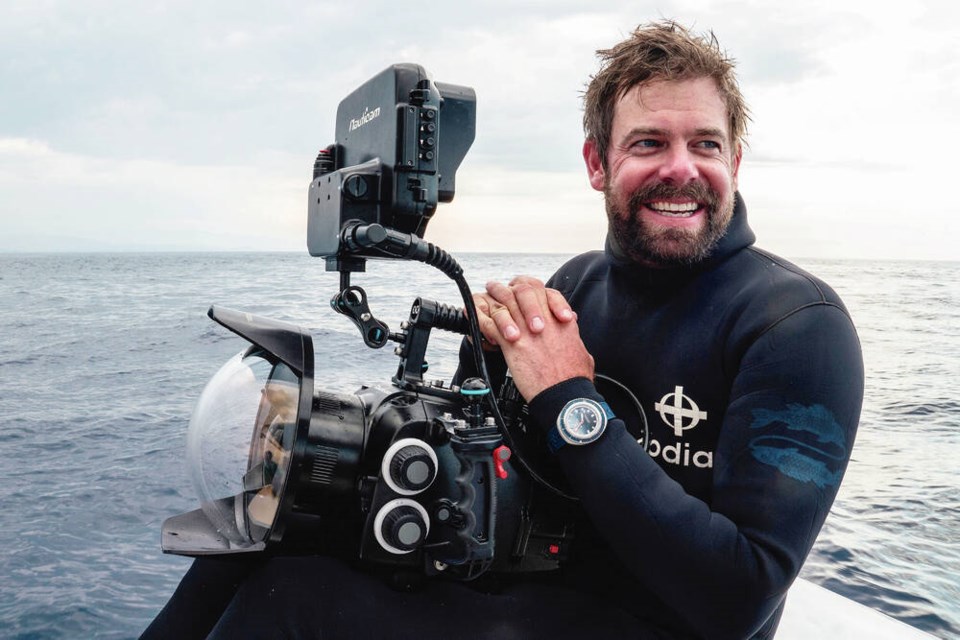NATIONAL GEOGRAPHIC LIVE
Where: Royal Theatre, 805 Broughton St.
When: Wednesday, Nov. 2, 7 p.m.
Tickets: $36.50-$47.50 from the Royal McPherson box office at 250-386-6121 or rmts.bc.ca
The first decade of Andy Mann’s photography career was all about adventure climbing — doing it, shooting it, living and breathing it.
The Virginia-raised Mann was lucky to be surrounded by like-minded individuals at the time, which made his entry into the world of adventure photography pretty much a given.
“I picked up a camera originally because I wanted to keep rock climbing full time,” Mann, 42, said from his home in Boulder, Colorado. “All my friends were sponsored athletes and professional rock climbers, so it kind of made sense — I already had all the access I’d need.”
While he still climbs today, the second half of his award-winning career has been singularly focused on the ocean. Mann is one of North America’s top ocean and adventure photographers and conservation filmmakers, with many of his notable photographs capturing sharks, whales and polar bears in a variety of habitats.
At his peak, Mann was spending roughly 100 days at sea. He’s on the water far less these days, as the Emmy Award nominee has moved into other areas related to SeaLegacy, a global non-profit company co-founded in 2014 by Nanoose Bay couple Paul Nicklen and Cristina Mittermeier. Mann joined the conservationists and fellow photographers in 2016 and now leads the organization’s impact media team, whose assets are key to campaigns that lobby for marine protection around the world.
The mission of the company headquartered in Qualicum Beach is to connect art, science and conservation with the specific purpose of improving the world in which we live.
“We’re in trouble unless we do something about the planet,” Mann said, when asked if the demise of our planet is greatly exaggerated or not exaggerated enough.
From Summit to Sea, his National Geographic Live multimedia presentation, differs from its ilk in that Mann eschews a linear narrative. His appearance Wednesday at the Royal Theatre, which will included a pre-show reception and post-show question-and-answer session with the photographer, will be more like a greatest hits package.
“It’s basically my journey as a storyteller,” he said. “Oddly enough, I don’t even show my best work. I show goofy pictures and tell stories.”
Mann’s fondness for misadventure shines through. “It’s a real relatable story. The hardest thing for me to do is sit up there and flip through pretty pictures. The show is a little bit more behind-the-scenes storytelling than presenting fine work. It’s so reaffirming for me for my images to not sit on a hard drive, or get buried in the scrolling feed of Instagram.”
He has documented expeditions on all seven continents for National Geographic magazine, which gives his multimedia presentations a unique voice. As seen through his camera lens, Mann’s world is a place where the interesting bits lay just below the surface. His portfolio is full of arresting split images taken while Mann was in the water, the results of which are often contradictory story lines taking place simultaneously.
“We always talk about this thin blue line that separates the ocean from humanity. Some people don’t go below that line. They see the ocean as this vast, blue, abundant body of water. But it’s not. It’s a living eco-system that is connected to the topside as much as the topside is connected to what’s underneath it. It’s nice to connect those worlds for people.”
For five years, Mann said he was fascinated with sharks. That eventually turned his attention to what was happening on shore; “topside stories” as the expert scuba diver calls them. His career in marine conservation grew out of concerns over what was happening to the world’s oceans and its inhabitants, and is now a driving force in his life.
His work on an expedition in Russia led officials to designate an area in that country as one of the world’s largest arctic national parks, while a similar project in Azores lead to a new marine protected area in Portugal. “It’s the old adage of people protect what they love. As soon as you have a passion, you care about it and want to be an ambassador for it.”
His photographs — some of which took a great deal of “Kodak courage” to capture, according to Mann — remain great conversation starters, no matter his purpose. And there are many definitions of what makes a perfect shot, according to Mann. Rarity, composition and degree of difficulty are all big factors, “but they don’t really matter” in the end, he said.
“Why it was created, and how that image is going to work on behalf of a certain species or place, is the real goal. A successful image to me is one that wakes people up.”



